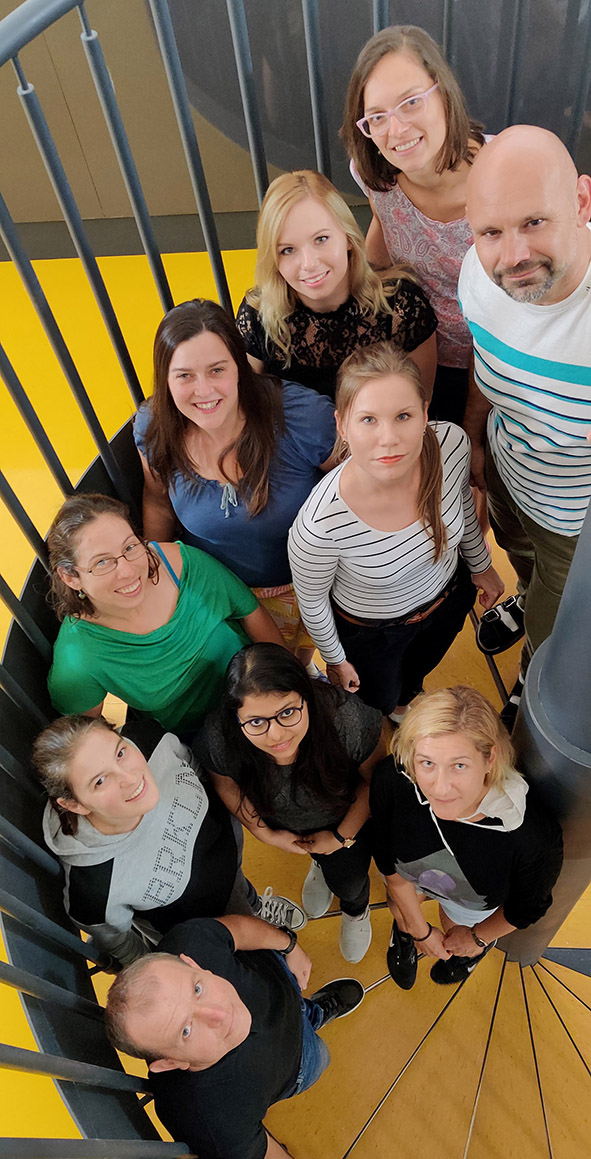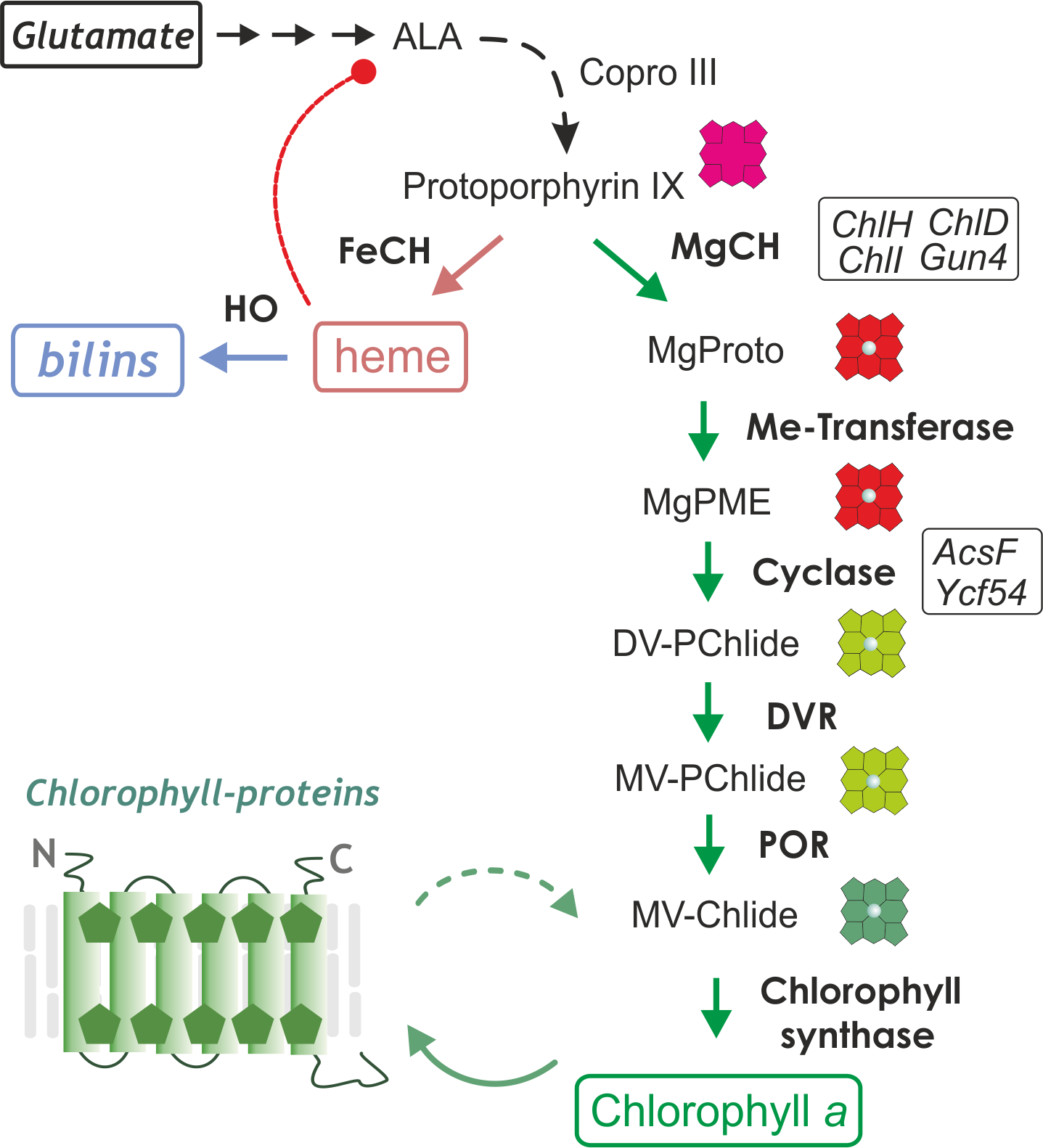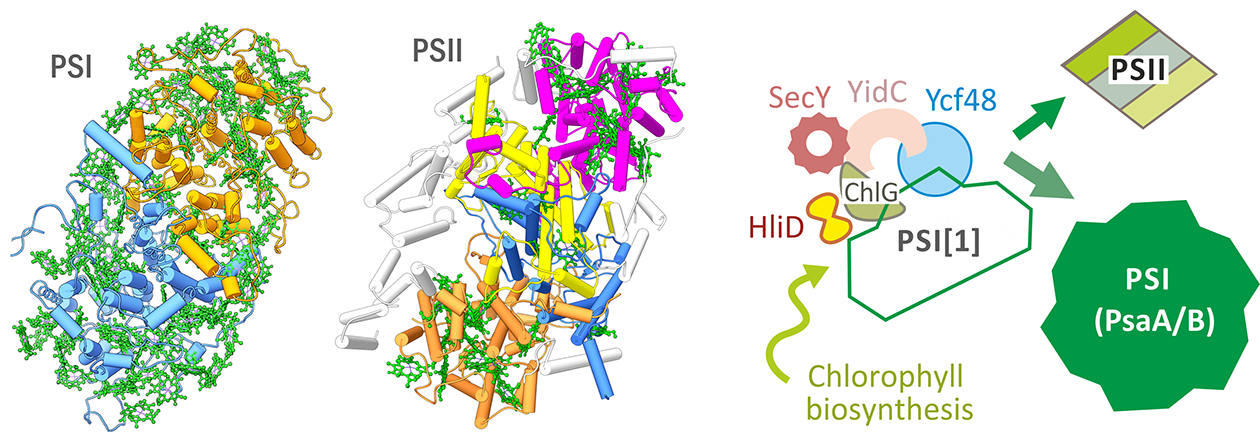Laboratory of Photosynthesis
Roman Sobotka`s group
Photosynthetic pigments
Roman Sobotka - Group of photosynthetic pigments

Photosynthesis is a fundamental biochemical process on Earth evolved by ancient microorganisms (cyanobacteria) around 3 billion years ago. Massive amount of oxygen, a by-product of photosynthesis has been then released into the atmosphere, changing completely the geochemistry of Earth and paving the way for the evolution of complex eukaryotic life. Our group studies various aspects of cyanobacterial cell biology but the key topics covered are the biogenesis of photosynthetic apparatus and the metabolism of photosynthetic pigments (see below). We have long-term experience with photosynthetic organisms, and we use a broad spectrum of multidisciplinary techniques, optimized for studies with phototrophs. Our favourite model is the unicellular cyanobacterium Synechocystis PCC 6803.

Biosynthesis of tetrapyrroles in cyanobacteria (oxygenic phototrophs)Chlorophylls and hemes are known as pigments of life due to their essential role in Earth biosphere. In photosynthetic organisms these pigments are synthesized in a common, long branched pathway together with other tetrapyrroles such are bilins or vitamin B12. As ‘free’ tetrapyrrole species including chlorophyll are generally phototoxic, tetrapyrrole metabolism must be under tight control; the regulatory mechanism is however still mostly unknown. We employ both reverse and forward genetic including mapping of suppressor mutations, and a broad spectrum of biochemical techniques, to elucidate how the metabolism of tetrapyrroles is controlled by the photosynthetic cell. |
 |
Scheme of the tetrapyrrole biosynthetic pathway in cyanobacteria and its connection to the biosynthesis of chlorophyll-binding proteins and chlorophyll recycling. It is generally accepted that heme acts as an allosteric inhibitor of the initial precursor 5-aminolevulinic acid (ALA), though the mechanism waits for explanation. |
|
Selected publications Chen, GE, Hitchcock, A, Mareš, J, Gong, Y, Tichý, M, Pilný, J, Kovářová, L, Zdvihalová, B, Xu, J, Hunter, CN, Sobotka, R: Evolution of Ycf54-independent chlorophyll biosynthesis in cyanobacteria. PNAS 118, e2024633118, 2021 Kopečná, J, Pilný, J, Krynická, V, Tomčala, A, Kis, M, Gombos, Z, Komenda, J, Sobotka, R. Lack of phosphatidylglycerol Inhibits chlorophyll biosynthesis at multiple sites and limits chlorophyllide reutilization in Synechocystis sp. strain PCC 6803. Plant Physiol 169, 1307-1317, 2015. Kopečná, J, Cabeza de Vaca, I, Adams, NB, Davison, PA, Brindley, AA, Hunter, CN, Guallar, V, Sobotka, R. Porphyrin binding to Gun4 protein, facilitated by a flexible loop, controls metabolite flow through the chlorophyll biosynthetic pathway. J Biol Chem 290, 28477-88, 2015. Sobotka, R, Dühring, U, Komenda, J, Peter, E, Gardian, Z, Tichý, M, Grimm, B, Wilde, A . Improtance of the cyanobacterial Gun4 protein for chlorophyll metabolism and assembly of photosynthetic complexes. J Biol Chem 283, 25794-25802, 2008. Sobotka, R, Komenda, J, Bumba, L, Tichý, M. Photosystem II assembly in CP47 mutant of Synechocystis sp. PCC 6803 is dependent on the level of chlorophyll precursors regulated by ferrochelatase. J Biol Chem 280, 31595-31602, 2015. |
Biosynthesis of chlorophyll-binding proteinsTo perform photosynthesis, cyanobacteria, algae and plants contain two specialized large membrane complexes called Photosystem I (PSI) and Photosystem II (PSI). These complexes are light-powered photo-oxidoreductases with many unique properties and they belong to the most complicated nano-devices evolved by nature. The main protein subunits of PSI and PSII bind number of chlorophyll molecules together with carotenoids and other cofactors. We use biochemical and structural approaches that includes protein pulldowns, 2D gel electrophoresis, protein mass-spectrometry and confocal microscopy to understand how chlorophyll-binding proteins are produced in the cell, protected against photo-damage and further assembled into larger complexes. On this topic we also collaborate with our partners at Sheffield University and at Imperial College, London. |

| According to our current model all large chlorophyll-binding subunits of the Photosystem I (PSI) and Photosystem II complexes (PSII) are produced by a similar molecular machineries (biogenetic centres; right) with a functional core consisting of the SecYEG translocon, YidC insertase and of the chlorophyll-synthase enzyme (ChlG) associated with Hlips (HliD). |
|
Selected publications Yu, J, Knoppová, J, Michoux, F, Bialek, W, Cota, E, Shukla, MK, Strašková, A, Pascual Aznar, G, Sobotka, R, Komenda, J, Murray, JW, Nixon, PJ. Ycf48 involved in the biogenesis of the oxygen-evolving photosystem II complex is a seven-bladed beta-propeller protein. PNAS 115, E7824-E7833, 2018. Bučinská, L, Kiss, É, Koník, P, Knoppová, J, Komenda, J, Sobotka, R. The Ribosome-Bound Protein Pam68 Promotes Insertion of Chlorophyll into the CP47 Subunit of Photosystem II. Plant Physiol 176, 2931-2942, 2018. Hollingshead, S, Kopečná, J, Armstrong, DR, Bučinská, L, Jackson, PJ, Chen, GE, Dickman, MJ, Williamson, MP, Sobotka, R, Hunter, CN. Synthesis of chlorophyll-binding proteins in a fully segregated Δycf54 strain of the cyanobacterium Synechocystis PCC 6803. Front in Plant Sci 7, 292, 2016. Knoppová, J, Sobotka, R, Tichý, M, Yu, J, Halada, P, Nixon, PJ, Komenda. Discovery of a Chlorophyll Binding Protein Complex Involved in the Early Steps of Photosystem II Assembly in Synechocystis. Plant Cell 26, 1200-1212, 2014. Chidgey, JW, Linhartová, M, Komenda, J, Jackson, PJ, Dickman, MJ, Caniffe, DP, Pilný, J, Hunter, N, Sobotka, R. A Cyanobacterial Chlorophyll Synthase-HliD Complex Associates with the Ycf39 Protein and the YidC/Alb3 Insertase. Plant Cell 26(3), 1267-1279, 2014. |
High light inducible protein (Hlips) - cyanobacterial ancestors of plant light-harvesting antennasThe combination of chlorophyll molecules, light, and oxygen is a toxic cocktail; particularly, if the light energy absorbed by chlorophylls is not immediately utilized for photosynthesis. If excited for ‘too long’ (>10-9 s) chlorophylls tend to switch to a so called triplet excited state that can react with oxygen, forming damaging oxygen radicals. Moreover, light absorption, oxygen production, and the synthesis of quantities of chlorophyll are processes that photosynthetic cells typically do at the same moment. It has been known from the mid-nineties that during stress conditions, cyanobacteria produce one-helix membrane proteins named High light inducible proteins (Hlips). Based on a characteristic chlorophyll-binding motif Hlips are widely accepted as ancestors of plant light harvesting complexes. We have discovered that Hlips are indeed bind chlorophylls and carotenoids and, more importantly, they are able to dissipate absorbed light energy as heat. We further explore how Hlips photo-protect cellular structures, and on this topic, we collaborate with with our colleagues from the University of South Bohemia, Paris (Sacley) and VU Amsterdam. |
|
The proposed dimer of Hlips is able, in a few ps, to transfer the energy of photons absorbed by chlorophyll molecules to a nearby-bound carotenoid. By an internal conversion of the carotenoid molecule the energy is safely dissipated as heat (‘warming’ the local environment). Our result demonstrated that such Hlips pair associates with the chlorophyll-binding subunits of PSII during the biogenesis of PSII and dissipates the energy of photons absorbed by the whole complex. |
|
Selected publications Skotnicová, P, Staleva-Musto, H, Kuznetsova, V, Bína, D, Konert, MM, Lu, S, Polívka, T, Sobotka, R: Plant LHC-like proteins show robust folding and static non-photochemical quenching. Nat Comm 12, 6890, 2021. Hontani, Y, Kloz, M, Polívka, T, Shukla, MK, Sobotka, R, Kennis, JTM. Molecular Origin of Photoprotection in Cyanobacteria Probed by Watermarked Femtosecond Stimulated Raman Spectroscopy. J Phys Chem Lett 9, 1788-1792, 2018 Llansola-Portoles, MJ, Sobotka, R, Kish, E, Shukla, MK, Pascal, AA, Polívka, T, Bruno, R. Twisting a β-Carotene, an Adaptive Trick from Nature for Dissipating Energy during Photoprotection. J Biol Chem 292, 1396-1403, 2017. Niedzwiedzki, DM, Tronina, T, Liu, H, Staleva, H, Komenda, J, Sobotka, R, Blankenship, RE, Polívka, T. Carotenoid-induced non-photochemical quenching in the cyanobacterial chlorophyll synthase-HliC/D complex. Biochim Biophys Acta 1857, 1430-9, 2016. Staleva, H, Komenda, J, Shukla, MK, Šlouf, V, Kaňa, R, Polívka, T, Sobotka, R. Mechanism of photoprotection in the cyanobacterial ancestor of plant antenna protein. Nat Chem Biol 11, 287-291, 2015. |
